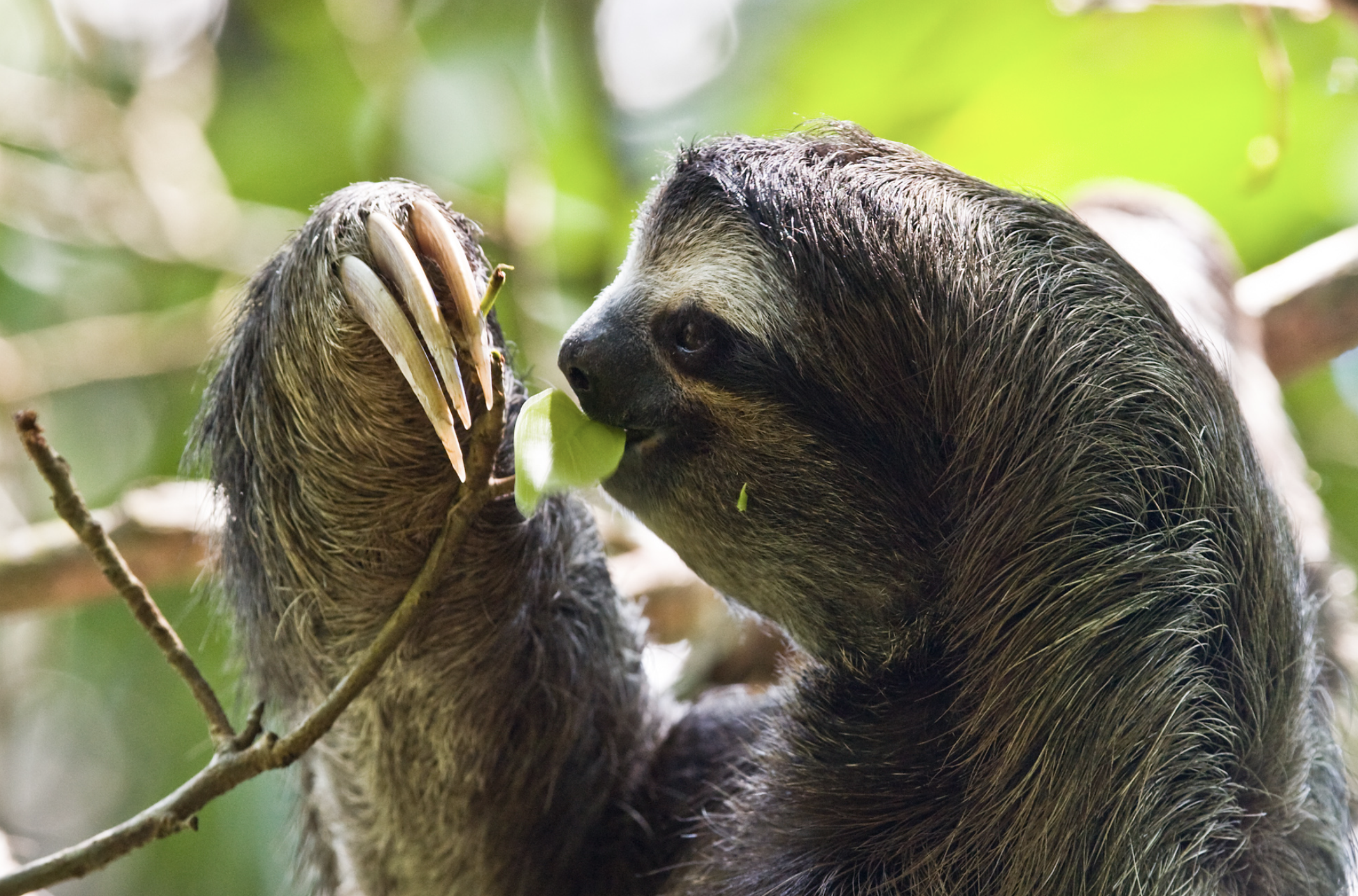On my first trip to Costa Rica, I was lucky enough to spot a three toed sloth high up in a cecropia tree on the side of the road. After watching it lick a leaf lethargically for 5 minutes through binoculars, my wife and I set off on a legendary hike up an ancient volcano called Cerro Chato. About 4 hours later, heading back to the car I thought about that sloth and how cool it looked with its algae painted green fur. ‘What an evolutionary oddity,’ I thought. Evolutionarily speaking, most mammals have opted for an active, voracious lifestyle. Not these present-day sloths. Being slow and steady doesn’t make them win the race by any means, but they do get by with the help of their ridiculous ecology.
The sloth we found. Phone picture through binoculars. San Carlos, Alajuela, Costa Rica.
We saw another sloth in captivity that same trip, in a facility that rehabilitates injured wildlife. This particular individual had clean, gray fur, not like the green fur of the wild sloth. I later learned that this green color reveals the microbiome existing on these slow-moving mammals and that this is a key property to this species success. The interesting ecology sloths carry out to maintain this fur microbiome was only just realized in 2014, when Jonathan N. Pauli and his teamset off to better understand a bizarre behavior these animals carry out on a weekly basis.
The metabolism of sloths is sluggish to say the least. As a result, they only poop once a week. Instead of defecating from the safety of the canopy, they traverse to the ground for their weekly doo-doo, which makes them way more vulnerable to predators. The researchers in this initial study had an inkling that this behavior must be carried out for some biological reason, since it puts the animals in grave danger. Upon closer investigation, these researchers witnessed mature moths jumping from the fur to its fecal matter. These moths then lay their eggs in the waste. Once the eggs hatch, the larvae feed on the sloth’s poop, where they mature and finally fly up to find their canopy inhabiting counterpart.
From the initial study, Pauli et. al 2014.
By taking fur samples of sloths with different densities of fur inhabiting moths, these scientists found that the higher the moth abundance, the higher the nitrogen concentration of their fur. Higher N concentration leads to more algal growth. The algae that grows on sloth fur is continuously fertilized by moths and their waste products. The growing algae offers several fitness enhancing functions to the sloths, from daily nutrition to cryptic coloration. A significant portion of their caloric demands come from these single celled plants when the sloths rake their teeth across their fur. The green coloration helps them blend in better with the canopy they live in, which reduces predation. Thirdly, and possibly most importantly, the algae absorbs water that the animal can drink. Largely inactive mammals with slow metabolisms don’t have the luxury of being able to seek out water every day. By maintaining this mutualism with moths and algae, sloths gain a lot. By looking even closer at these fur microbiomes, it turns out that humans may have something to gain as well.
Both (a) three- and (b) two-toed sloths harbour a diverse ecosystem in their fur. (c–e) The more sedentary three-toed sloths (black bars) possessed (c) a greater number of moths, (d) more inorganic nitrogen in the form of NH4 (e) greater algal biomass on their fur compared with two-toed sloths (grey bars) Pauli et. al 2014.
The same year of the initial study,Sarah Higginbotham and her teamwanted to delve deeper into this microbiome and see if there was any pharmaceutical potential. Novel habitats almost always contain a slew of bioactive microbes that can eventually be used to treat human pathogens and diseases. This fur habitat was no different, as wide diversity of fungi was found to be living alongside the moths and algae. Out of the 84 species of fungi isolated from sloth fur, 20 were active against at least one bacterial strain. Perhaps most intriguing result is the bioactivity against the breast cancer cell line MCF-7. 15 of the 73 (20.6%) fungal extracts tested against this cancer cell line reduced cancer cell growth by 50% or more! Truly a staggering result from a tiny ecosystem we just learned about.
After that legendary hike in Central America, I found myself yearning to see that sloth again. I never see sloths, let alone on in its natural habitat. I was heading back the Western NY in just a few days, and knew that my chances of finding another sloth was fleeting. I then remembered how lethargic these animals are and set off to find the sloth in that same cecropia tree. Lone and behold, there it was. Surprisingly, it actually moved about 8 feet onto another cecropia branch. For another ten minutes I gazed at my filthy little friend that eats, drinks, and becomes more camouflaged from the algae growing on its fur that is continuously fertilized by the moths that matured in the animal’s poop. Little did I know the pharmaceutical potential these tiny ecosystems behold.





